
Electricity for the Trades
3rd Edition
ISBN: 9781260437386
Author: Petruzella, Frank
Publisher: MCGRAW-HILL HIGHER EDUCATION
expand_more
expand_more
format_list_bulleted
Concept explainers
Textbook Question
Chapter 1.1, Problem 1RQ
Does the severity of an electric shock increase or decrease with each of the following changes?
- a. A decrease in the source voltage.
- b. An increase in body current flow.
- c. An increase in body resistance.
- d. A decrease in the length of time of exposure.
Expert Solution & Answer
Want to see the full answer?
Check out a sample textbook solution
Students have asked these similar questions
A 3-phase, 4-wire distributor supplies a balanced voltage of 400/230 V to a load consisting of 8 A at p.f. 0-7
lagging for R-phase, 10 A at p.f. 0-8 leading for Y phase and 12 A at unity p.f. for B phase. The resistance
of each line conductor is 0.4 2. The reactance of neutral is 0.2 2. Calculate the neutral current, the supply
voltage for R phase and draw the phasor diagram. The phase sequence is RYB. IN
ER
VR
Ref
A 3-phase, 4-wire distributor supplies a balanced voltage of 400/230 V to a
load consisting of 50 A at p.f. 0-866 lagging for R-phase, 30 A at p.f. 0-866 leading for Y phase and
30 A at unity pf. for B phase. The resistance of each line conductor is 0-2 Q. The area of X-section
of neutral is half of any line conductor: Calculate the supply end voltage for R phase. The phase
sequence is RYB.
- A 3-phase, 4-wire distributor supplies a balanced voltage of 400/230 V to a load consisting of 8 A at p.f. 0.7
lagging for R-phase, 10 A at p.f. 0-8 leading for Y phase and 12 A at unity p.f. for B phase. The resistance
of each line conductor is 0.4 2. The reactance of neutral is 0.2 2. Calculate the neutral current, the supply
voltage for R phase and draw the phasor diagram. The phase sequence is RYB.
Chapter 1 Solutions
Electricity for the Trades
Ch. 1.1 - Does the severity of an electric shock increase or...Ch. 1.1 - In general, voltage levels above what value are...Ch. 1.1 - In general, current levels above what value are...Ch. 1.1 - What circuit fault can result in an arc flash?Ch. 1.1 - Define each of the following terms associated with...Ch. 1.1 - Explain why an arc flash is so potentially...Ch. 1.1 - What is a permit-required confined space?Ch. 1.1 - What does the term personal protective equipment...Ch. 1.1 - What personal protective attire is required when...Ch. 1.1 - When should face shields be worn?
Ch. 1.1 - A fall arrest system must be rigged so that...Ch. 1.1 - A ladder is used to reach the top of a building 16...Ch. 1.1 - What are the deck requirements for a scaffold work...Ch. 1.1 - Prob. 14RQCh. 1.1 - List the three ingredients required to sustain a...Ch. 1.1 - Which classes of fire are multipurpose...Ch. 1.1 - List four hazardous properties or characteristics.Ch. 1.2 - Prob. 1RQCh. 1.2 - Compare the terms grounding and bonding.Ch. 1.2 - Why is the earth not considered to be an effective...Ch. 1.2 - Explain what is meant by a ground fault.Ch. 1.2 - How does a ground-fault circuit interrupter (GFCI)...Ch. 1.2 - How does a ground-fault circuit interrupter (GFCI)...Ch. 1.2 - Explain what is meant by an arcing fault.Ch. 1.2 - Compare the amount of current that results from...Ch. 1.2 - Compare what GFCIs and AFCIs protect against.Ch. 1.2 - What does a lockout-tagout procedure refer to?Ch. 1.2 - Prob. 11RQCh. 1.2 - A voltmeter is used to verify that no voltage is...Ch. 1.2 - What is the main goal of OSHA?Ch. 1.2 - What is the primary purpose of the rules set forth...Ch. 1.2 - Assume a piece of electrical equipment has been...Ch. 1.2 - How often is the National Electrical Code updated...
Knowledge Booster
Learn more about
Need a deep-dive on the concept behind this application? Look no further. Learn more about this topic, electrical-engineering and related others by exploring similar questions and additional content below.Similar questions
- Please show all the steps!arrow_forwardPlease show all the steps!arrow_forward10-3) similar to Lathi & Ding, Prob. P.6.3-7 The Fourier transform P(f) of a the basic pulse p(t) used in a certain binary communication is shown in the figure below: P(f) 1 0.5 0 f₁ = 0.8 √₂ = 1.2 f, MHz (a) From the shape of P(f), explain at what pulse rate this pulse would satisfy Nyquist's first criterion. (b) Assuming that the pulse is a raised-cosine pulse, find its rolloff factor. (c) Find p(t) and verify that this pulse satisfies Nyquist's first criterion in the time domain. (d) Show how rapidly the pulse decays as a function of t, (i.e., what power of t does the envelope obey for large time values).arrow_forward
- Choose the correct answer for from the following sentences: 1. The purpose of the microprocessor is to control b. memory c. processing d. tasks a. switches 2. Which of the following instructions represents base-plus-index addressing mode? a. MOV AL,[BX] b. MOV AL,[SI] c. MOV AL,BX d. MOV AL,[BX+SI] 3. The BIU pre-fetches the instruction from memory and store them in b. memory c. stack d. queue a. register 4. Which function is used to control the PWM (Pulse Width Modulation) on the Arduino output pin? a. digitalRead() b. analogRead() c. digitalWrite() 5. Which port in the PIC16F877A has an 8 external interrupt inputs? a. Port-A b. Port-C c. Port-B d. analogWrite() d. Port-D d. 4KByte 6. How much Flash EEPROM memory program found in the PIC16F877A microcontroller? a. 32KByte b. 16KByte c. 8KBytearrow_forwardSolve and select the correct answer: 2. For a random variable X with pdf: p(x) value of x is = 119 10 for -5≤x≤5. The mean (a) -75 (b) 10 (c) 0 (d) 75 3. Is the matrix A = = [1] orthogonal? Find the rank of A? 0 (a) YES, -1 (b) NO, 2 (c) YES, 2 (d) NO, -1 4. L{et sin(3t)u(t)) = (a) s-3 (s-2)²+9 2 (b) (5-3)² (c) (s-3)²+4 S-2 3 (s-2)²+9 (d) (5-2)²+9 = 5. Given that x is a constant. Choose all the correct solutions for [∞ (AB)] = (a) (AB)T (b) x ATBT (c) α BTAT (d) x (AB)Tarrow_forwardDO NOT WANT AI WILL REJECTarrow_forward
arrow_back_ios
SEE MORE QUESTIONS
arrow_forward_ios
Recommended textbooks for you
 EBK ELECTRICAL WIRING RESIDENTIALElectrical EngineeringISBN:9781337516549Author:SimmonsPublisher:CENGAGE LEARNING - CONSIGNMENT
EBK ELECTRICAL WIRING RESIDENTIALElectrical EngineeringISBN:9781337516549Author:SimmonsPublisher:CENGAGE LEARNING - CONSIGNMENT

EBK ELECTRICAL WIRING RESIDENTIAL
Electrical Engineering
ISBN:9781337516549
Author:Simmons
Publisher:CENGAGE LEARNING - CONSIGNMENT
How Electric Motors Work - 3 phase AC induction motors ac motor; Author: The Engineering Mindset;https://www.youtube.com/watch?v=59HBoIXzX_c;License: Standard Youtube License